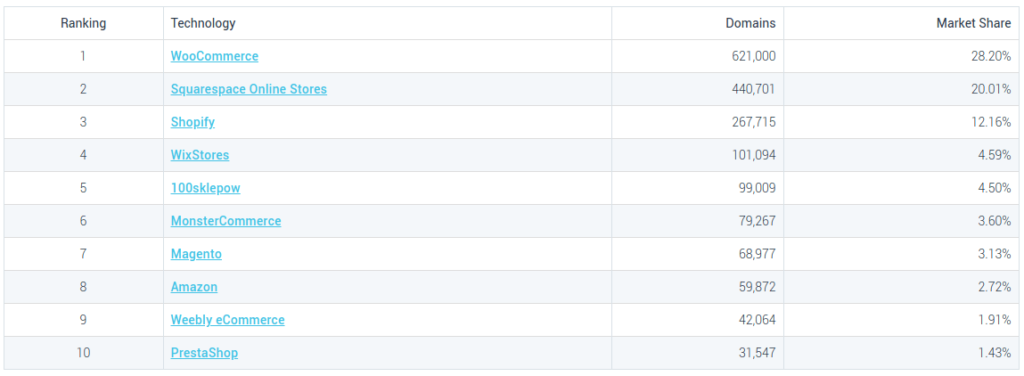The latest chapter in the ongoing story of eCommerce sees our hero finding an unlikely ally in COVID-19. Lockdown measures have contributed to a big spike in online orders this year and the shift away from physical retail has accelerated by years in a matter of months.
Luckily it’s easier than ever to establish your online presence. With a multitude of eCommerce platforms ready to go, there’s never been a better time to get stuck in. I’m going to cover one of those platforms here, and I’m assuming you’ve guessed which it is.
Checking out WooCommerce
WooCommerce is an eCommerce platform based on the extremely popular WordPress CMS platform. Right now it drives 28-29% of the eCommerce market, putting it ahead of competitors such as Shopify, Magento, and even Amazon. This is no mean feat, and prompts a simple question: why?

It’s free, forever
WooCommerce is open-source software and therefore free not only to download and use but to modify and extend as required. Allowing for lower project costs, but removes barriers to learning and tinkering (which developers love to do).
It’s got options
Being based on WordPress grants access to a massive ecosystem of plugins and themes for extending and presenting websites. Whatever problems you face, the chances are that others have had the same issues and developed solutions that you can use. Some are premium or subscription-based, and others are completely free.
It’s well supported
The platform is maintained and improved by collaborators from across the world, all of whom were remote working before it was cool. Thousands more work with the platform every day so you don’t have to go far to find someone who can build a WooCommerce site – or support an existing one.
It’s secure
The industry leader Sucuri regularly audits the WooCommerce codebase to ensure online stores and customer data are is as safe as possible.
A cartful of features
WooCommerce will comfortably cover the eCommerce needs of most small businesses (and likely a lot of larger ones) out of the box. The full feature set is too wide to cover here but I’ll focus on the important stuff and some notable extensions.

Products
The meat and potatoes of any online store (literally, if you happen to sell them). Several product types are available, from simple products to products with options to products that are grouped or associated in a variety of ways.
Products can be physical or digital, so you’re not limited to stock – you might instead sell services, downloads or bookings. Individual products host a variety of standard options, from SKUs to dimensions and weights, upsells/cross-sells, sale prices, and more besides.
Customers can navigate, sort, and filter products based on flexible categorisation and tagging options too. Products are very well supported and will satisfy most requirements!
Cart
The trusty cart does exactly what you expect it to; no less. Customers can review their subtotal and manage the products they’ve added, changing quantities or removing items as they desire. Various extensions such as Smart Cart provide additional flexibility.
Checkout
It captures customer name and address details, displays shipping options, applies tax, summarises the order, and captures payment. None of this should be surprising – it’s got the basics covered so you can get up and running quickly. It can be extended to support subscriptions so you can offer regular deliveries or ongoing services.
Shipping
You can configure multiple potential destinations and charges geographically using shipping zones and shipping classes applied to specific products or groups of products. If your needs are more complex then table rate shipping is possible, and plugins are also available to support all popular courier services.
Payment
There is support for most major payment providers. The options available depend on the provider (for example, some provide better support for subscriptions than others) so it’s a good idea to figure out which provider you want to use! Basic payment options such as cheque and local pickup are available too.
Tax
Products can be added including or excluding tax and different tax rates can be configured for different countries. Of course, several plugins are also available to support VAT numbers, exemptions, and automation.
Coupons
Some simple coupon types are available and provide features such as percentage and fixed discounts, expiration dates, and a variety of other usage limits.
Reports
WooCommerce tracks your store stats and provides reports about orders, customers, stock, and taxes. It’s a great way to keep track of your store’s performance, and there are plenty of options for expanding on this and integrating with other platforms and fit your needs.
The other side of the coin
WooCommerce is a great option a lot of of the time, but it’s not for everyone.

Ah, but I have a very large inventory?
There are no explicit technical limits but you may struggle if you have a complex inventory with hundreds of product attributes and cross-categorisation. Investing in top-notch hosting/storage and a team of developers dedicated to optimisation will do wonders here.
Okay, but WordPress isn’t my main CMS?
If you’re not keen on using WordPress as your main CMS then you might consider other options. However, WooCommerce comes equipped with an API. This makes it possible to integrate it with other systems, so it might still be an option.
Although WooCommerce provides many great features out of the box, you’ll want a team of developers to help cater for your more specific needs.
Thank you, come again
Hopefully, you now understand what WooCommerce offers, and how you can take advantage of this very successful platform. If you want to explore WooCommerce as an option for your online store, drop us a line.







